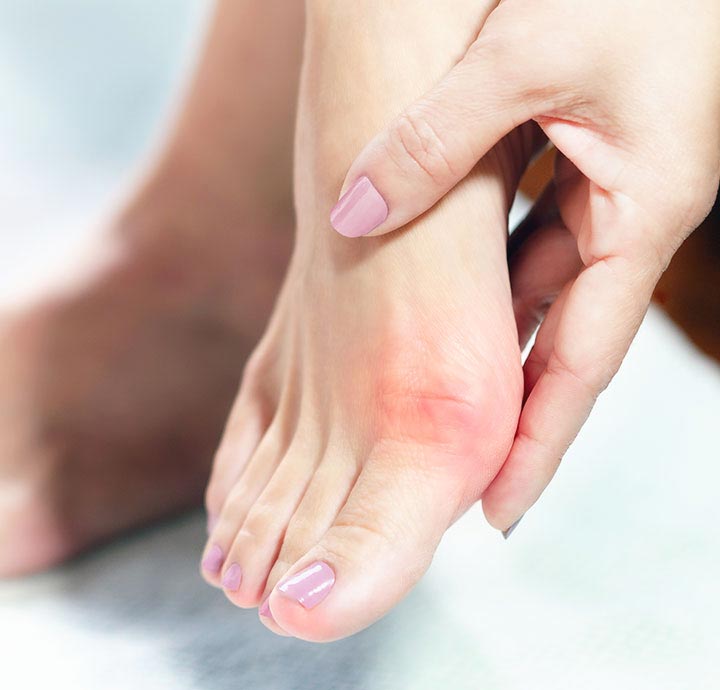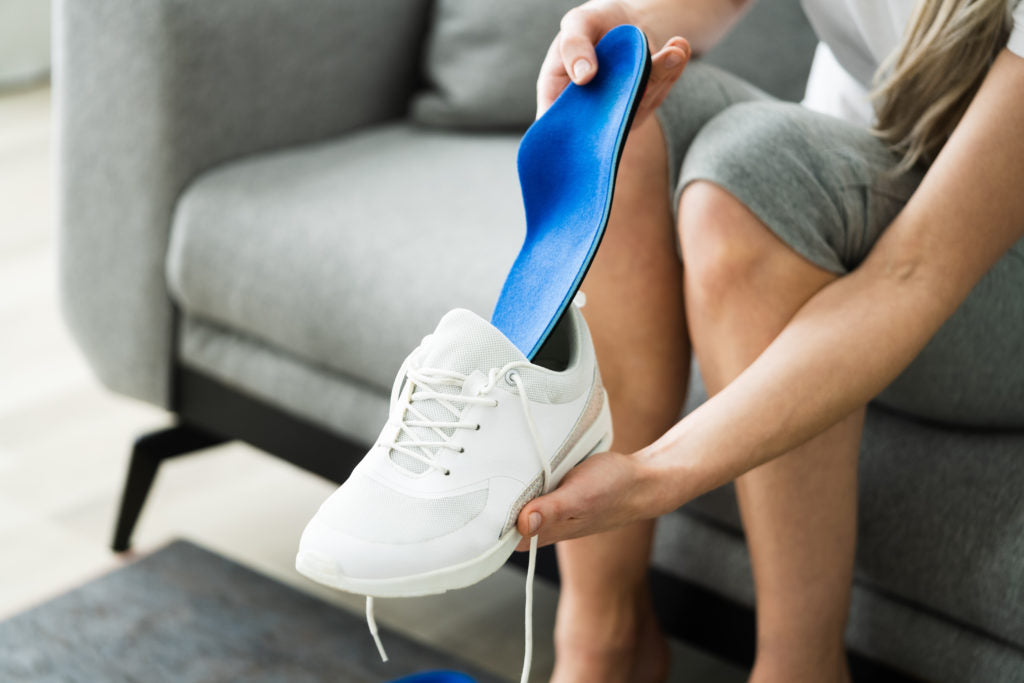
Bunions, also known as hallux valgus, are often described as looking like a bump or enlargement on the side of the big toe. A bunion occurs when the joint at the base of the big toe becomes enlarged and repositioned to lean toward the second toe. The joint at the base of the little toe can also be affected.
Pain or stiffness in the big toe is one of a handful of bunion symptoms. Bunions can cause the foot to evert or turn outward, making it difficult to walk. While you may never develop symptoms from having a bunion, symptoms usually become more noticeable as the condition progresses.
Symptoms can include:
• A bump on the outside of the base of the big or little toe
• Pain or decreased motion of your big toe, which may make walking difficult
• Redness and swelling of your big toe joint
• A feeling of burning or numbness
• A thickening of the skin at the affected area
• Development of corns or calluses where the toes overlap
While regular bunions affect the big toe, Tailor’s bunion – also known as a bunionette – is a bump that forms on the side of the little toe. The name stems from the way tailors used to sit, cross-legged with one leg tucked under the other, putting pressure on the little toe. Tailor’s bunions are not as common as regular bunions, but they have similar symptoms and causes.
Bunions form when the bones in the larger joint of your big toe becomes misaligned. There are multiple factors that can contribute to bunions. For example:
• Wearing poorly fitting shoes, especially ones that are too narrow or restricting, such as high heels. Continuing to wear these shoes can also make symptoms worse.
• Inherited factors or abnormal walking motions causing undue stress on your feet
Although bunions tend to be most common in women, anyone – even children – can get them.
Sometimes X-rays are ordered to determine the integrity of the joints of the foot and to screen for underlying conditions.
Bunions tend to form slowly over time, so while you may not notice until it is fully formed, there are some things that can help lessen the chances of developing one. An important way to prevent the pain and worsening of bunions is to choose the right shoes. It is best to avoid wearing shoes that compress or cramp the toes. Shoes with a wide toe area work best. Narrow-fitting shoes are also best to avoid. Make sure that your shoes don’t squeeze or press into any part of your foot. High heels and shoes with pointed toes in particular can often worsen bunion pain and make the condition worse.

If you have bunions, symptoms and pain may be mitigated by taking a few simple steps, like:
• Wearing well-fitting shoes to help slow down the progression of bunions and alleviate discomfort. Children can also develop bunions and should wear properly fitting shoes as their feet are still developing
• Using a bunion cushion to alleviate discomfort. Dr. Scholl’s Bunion Cushions with Duragel® technology are clinically proven to ease bunion pain by reducing shoe pressure and friction.
• Applying ice: Using ice on your bunion can help to reduce swelling and soreness.
• Changing your shoes: Try shoes with a wide toe box and avoid high heels and shoes with a pointed toe.
• Shoe inserts: Insoles and Inserts provide padding that can limit bunion pain. The use of felt or foam padding on the foot may help protect the bunion from irritation. Depending on the structure of your foot, custom insoles might add further support and repositioning.
• Padding, taping or splinting: To control pain and stress on your bunion, your doctor may be able to assist you with using a bunion pad, bunion splint or bunion corrector.
Padding, taping or splinting: To control pain and stress on your bunion, your doctor may be able to assist you with using a bunion pad, bunion splint or bunion corrector.
• Using over-the-counter pain relievers, as needed.
See your doctor if you find your pain persists even after self-care, or if your pain prevents you from doing your usual everyday activities. Having long-lasting pain, a visible bump on your toe joint, reduced mobility of your foot or toe, and difficulty finding shoes that fit properly are also good reasons to see your doctor. For a severe bunion, the doctor may recommend a bunion surgery, or bunionectomy, to relieve the symptoms associated with having a bunion.
Related Articles
Frequently Asked Questions
How to get rid of bunions
How to shrink bunions naturally
• Wear comfortable shoes that fit well and provide plenty of room in the toe box and along the sides of the shoes. Avoid high heels and tight shoes that compress or squeeze the feet.
• Consider wearing orthotics with shoes as they can help position the foot correctly in order to minimize pressure on the bunion.
• Apply cushions or moleskin to protect the bunion.
• Ice the affected area several times a day for up to 20 minutes at a time to reduce pain and swelling.
• Try to maintain a healthy weight in order to lessen pressure on the bunion when walking and standing.
• Ask your doctor if a night splint is appropriate for you. Night splints can help place the toe in a proper position, taking pressure off of the bunion. Toe spacers or separators may also be helpful.
What does a bunion look like?
How to fix bunions
• Good shoes – Properly fitted shoes are the first line of defense when it comes to bunions. Avoid wearing high heels or tight shoes that press on the feet.
• Icing – Apply an ice pack to the bunion several times a day for up to 20 minutes in order to ease swelling and pain.
• Cushions – Try using bunion cushions to relieve pressure when wearing shoes.
• Orthotics – Wear orthotics with shoes to help improve alignment and reduce pressure on the bunion.
• Night splints – Ask your doctor about recommending a night splint in order to improve the position of the toe while sleeping. You might also consider using toe separators or spacers.
• Massage – Gently massage the area around the base of the big toe regularly to help ease stiffness and improve mobility.
More serious bunions that cause severe pain and make it difficult to walk may require surgery. Bunions cannot be completely corrected without surgery.
Do bunion correctors work?
Are bunions hereditary?
What does bunion pain feel like?
How do you get bunions?
• High heels and improperly fitted shoes – Constant pressure from shoes that are too tight, don’t fit right or force the foot into a cramped toe box may contribute to the formation of a bunion.
• Rheumatoid arthritis – Because rheumatoid arthritis is an inflammatory condition that causes joint damage, it can increase the chances of joint problems in the foot, including bunions.
• Genetics – Some people are more prone to bunions because of their foot structure. Those with flat feet or loose tendons and joints may have a higher chance of developing bunions. Deformities of the feet can also make people more vulnerable to bunions.
• Injuries – Foot injuries can cause structural changes to the foot and joint damage which may increase the risk of bunions.
How do bunions form?
How long is recovery from bunion surgery?
Additional Resources
• https://www.webmd.com/skin-problems-and-treatments/understanding-bunions-treatment
• https://www.healthline.com/health/how-to-get-rid-of-bunions#15-tips
• https://health.clevelandclinic.org/7-ways-to-ease-your-bunions-without-surgery/
• https://www.mayoclinic.org/diseases-conditions/bunions/symptoms-causes/syc-20354799#:~:text=The%20signs%20and%20symptoms%20of,toes%20rub%20against%20each%20other
• https://www.health.harvard.edu/diseases-and-conditions/what-to-do-about-bunions
• https://orthoinfo.aaos.org/en/diseases–conditions/rheumatoid-arthritis-of-the-foot-and-ankle
• https://my.clevelandclinic.org/health/diseases/14386-bunions-hallux-valgus
• https://my.clevelandclinic.org/health/treatments/15383-bunion-correction-surgery#:~:text=Usually%2C%20you%20will%20get%20your,your%20weight%20on%20your%20foot
• https://www.uofmhealth.org/health-library/hw33928


